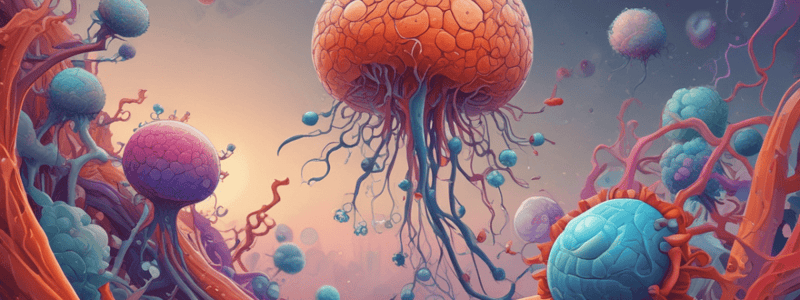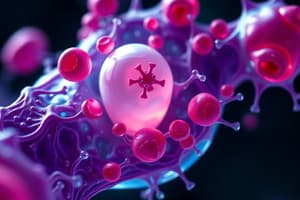Podcast
Questions and Answers
What is the function of the plasma membrane in a cell?
What is the function of the plasma membrane in a cell?
- It contains genetic material.
- It separates the cell from its environment. (correct)
- It stores nutrients for the cell.
- It provides energy for metabolism.
Which type of cell lacks a nucleus?
Which type of cell lacks a nucleus?
- Prokaryotic cells (correct)
- Animal cells
- Eukaryotic cells
- Plant cells
What is the primary outcome of cellular respiration?
What is the primary outcome of cellular respiration?
- Division of the cell into two identical cells.
- Creation of glucose from light energy.
- Transfer of genetic information to offspring.
- Conversion of glucose into energy. (correct)
What does the process of meiosis produce?
What does the process of meiosis produce?
What is natural selection?
What is natural selection?
What is a mutation?
What is a mutation?
What are biotic factors in an ecosystem?
What are biotic factors in an ecosystem?
What does speciation refer to?
What does speciation refer to?
Flashcards are hidden until you start studying
Study Notes
Cells
- Basic structural and functional units of living organisms
- Consist of:
- Plasma membrane: outermost layer, separates cell from environment
- Cytoplasm: gel-like substance inside plasma membrane
- Nucleus: contains genetic material (DNA)
- Cell types:
- Prokaryotic cells: no nucleus, small, simple structure (e.g. bacteria)
- Eukaryotic cells: nucleus, larger, more complex structure (e.g. plants, animals)
Cellular Processes
- Metabolism: conversion of energy and nutrients within cells
- Photosynthesis: process by which plants convert light energy into glucose
- Cellular respiration: process by which cells generate energy from glucose
- Mitosis: process of cell division, resulting in two identical daughter cells
- Meiosis: process of cell division, resulting in four non-identical daughter cells (gametes)
Genetics
- DNA (Deoxyribonucleic acid): molecule containing genetic information
- Genes: segments of DNA that code for specific traits
- Traits: characteristics of an organism, determined by genes
- Inheritance: passing of traits from parents to offspring
- Mutations: changes in DNA sequence, can result in new traits or diseases
Evolution
- Theory of evolution: process by which species change over time through natural selection
- Natural selection: process by which individuals with favorable traits are more likely to survive and reproduce
- Speciation: process by which new species emerge
- Fossil record: evidence of evolution through fossilized remains of ancient organisms
- Comparative anatomy: study of similarities and differences in body structure among species
Ecosystems
- Ecosystem: community of living and non-living components interacting in an environment
- Biotic factors: living components (e.g. plants, animals, microorganisms)
- Abiotic factors: non-living components (e.g. water, sunlight, temperature)
- Energy flow: transfer of energy from one organism to another through food chains and webs
- Nutrient cycling: recycling of nutrients through ecosystems
Diversity of Life
- Kingdoms: highest level of classification, includes:
- Monera (bacteria)
- Protista (eukaryotic microorganisms)
- Fungi
- Plantae (plants)
- Animalia (animals)
- Phyla: level of classification below kingdoms, groups organisms based on body structure
- Classes: level of classification below phyla, groups organisms based on shared characteristics
Cells
- Fundamental units of all living organisms, responsible for various functions.
- Composed of three main parts:
- Plasma Membrane: Acts as a barrier, controlling the movement of substances in and out of the cell.
- Cytoplasm: A viscous fluid that contains organelles and is the site for many cellular processes.
- Nucleus: Houses DNA, which contains instructions for cellular functions and heredity.
- Types of cells:
- Prokaryotic Cells: Lacks a defined nucleus; typically smaller and simpler (e.g., bacteria).
- Eukaryotic Cells: Contains a nucleus; larger and more complex (e.g., plant and animal cells).
Cellular Processes
- Metabolism: Encompasses all chemical reactions that convert energy and nutrients to sustain cellular activities.
- Photosynthesis: A process utilized by plants to convert light energy into chemical energy (glucose).
- Cellular Respiration: The mechanism by which cells extract energy from glucose, producing ATP (adenosine triphosphate).
- Mitosis: A method of somatic cell division that results in two genetically identical daughter cells.
- Meiosis: A specialized form of cell division resulting in four non-identical gametes, essential for sexual reproduction.
Genetics
- DNA (Deoxyribonucleic acid): The hereditary material that encodes genetic information essential for life.
- Genes: Specific sequences of DNA that determine particular traits or characteristics in an organism.
- Traits: Observable characteristics influenced by genetic makeup, passed down through generations.
- Inheritance: The mechanism by which genetic traits are transmitted from parents to offspring during reproduction.
- Mutations: Random changes in the DNA sequence that can lead to variations in traits, some beneficial, others detrimental.
Evolution
- Theory of Evolution: Describes how species evolve over time through processes like natural selection and genetic mutation.
- Natural Selection: A mechanism by which individuals with advantageous traits are more likely to survive and reproduce, influencing species over generations.
- Speciation: The evolutionary process by which new biological species arise from existing species.
- Fossil Record: Provides historical evidence of the evolution of species through the remnants of ancient life forms.
- Comparative Anatomy: Investigates the anatomical similarities and differences among species, offering insights into evolutionary relationships.
Ecosystems
- Ecosystem: A system formed by the interaction of living (biotic) and non-living (abiotic) components within an environment.
- Biotic Factors: Include all living organisms such as plants, animals, and microorganisms that interact within an ecosystem.
- Abiotic Factors: Comprise non-living elements like water, sunlight, air, and minerals that influence the ecosystem's environment.
- Energy Flow: Involves the transfer of energy through food chains and webs, beginning with primary producers and moving through various consumers.
- Nutrient Cycling: The process of recycling nutrients, essential for maintaining ecosystem health and balance.
Diversity of Life
- Kingdoms: The highest classification level, encompassing major groups of life:
- Monera: Contains bacteria and archaea, unicellular organisms.
- Protista: Composed of diverse eukaryotic microorganisms.
- Fungi: Includes yeasts, molds, and mushrooms.
- Plantae: All plants, characterized by photosynthetic capabilities.
- Animalia: Multicellular organisms that typically consume organic material for energy.
- Phyla: A classification level below kingdoms that groups organisms based on significant structural features.
- Classes: A further classification below phyla, organizing organisms based on shared traits and evolutionary history.
Studying That Suits You
Use AI to generate personalized quizzes and flashcards to suit your learning preferences.




